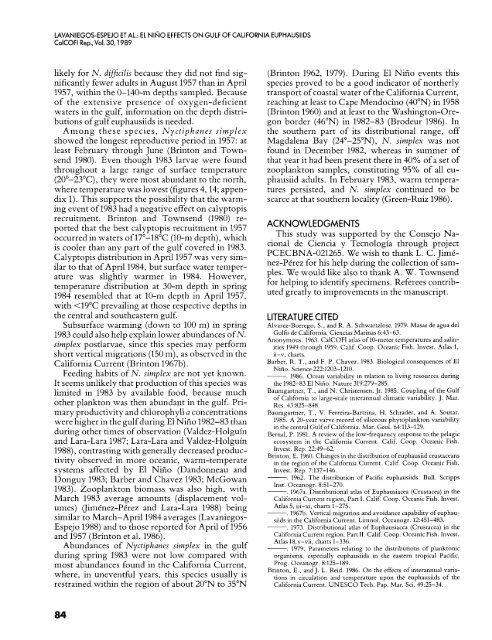CalCOFI Reports, Vol. 30, 1989 - California Cooperative Oceanic ...
CalCOFI Reports, Vol. 30, 1989 - California Cooperative Oceanic ...
CalCOFI Reports, Vol. 30, 1989 - California Cooperative Oceanic ...
You also want an ePaper? Increase the reach of your titles
YUMPU automatically turns print PDFs into web optimized ePapers that Google loves.
I<br />
LAVANIEGOS-ESPEJO ET AL.: EL NINO EFFECTS ON GULF OF CALIFORNIA EUPHAUSIIDS<br />
CalCOFl Rep., <strong>Vol</strong>. <strong>30</strong>,<strong>1989</strong><br />
likely for N. dfjcilis because they did not find significantly<br />
fewer adults in August 1957 than in April<br />
1957, within the 0-140-m depths sampled. Because<br />
of the extensive presence of oxygen-deficient<br />
waters in the gulf, information on the depth distributions<br />
of gulf euphausiids is needed.<br />
Among these species, Nyctiphanes simplex<br />
showed the longest reproductive period in 1957: at<br />
least February through June (Brinton and Townsend<br />
1980). Even though 1983 larvae were found<br />
throughout a large range of surface temperature<br />
(20"-23"C), they were most abundant to the north,<br />
where temperature was lowest (figures 4,14; appendix<br />
1). This supports the possibility that the warming<br />
event of 1983 had a negative effect on calyptopis<br />
recruitment. Brinton and Townsend (1980) reported<br />
that the best calyptopis recruitment in 1957<br />
occurred in waters of 17"-18"C (10-m depth), which<br />
is cooler than any part of the gulf covered in 1983.<br />
Calyptopis distribution in April 1957 was very similar<br />
to that of April 1984, but surface water temperature<br />
was slightly warmer in 1984. However,<br />
temperature distribution at <strong>30</strong>-m depth in spring<br />
1984 resembled that at 10-m depth in April 1957,<br />
with















